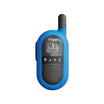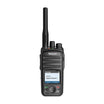In a traditional FDMA two-way radio implementation, each transmission occupies a full 12.5 kHz channel. A single channel can accommodate a single, half-duplex call. Proprietary implementations that use FDMA to achieve two 6.25 kHz equivalent channels enable two conversations to take place within a 12.5 kHz channel — but again, both of these conversations are half-duplex, and there’s no flexibility to put the extra capacity to any other use. TDMA-based digital systems with two time slots aren’t bound by these technical restrictions. The two time slots can be used to carry two half-duplex conversations — as with the two sub-channels in an FDMA-based system — but with no need for extra equipment and no danger of reduced performance. Unlike FDMA, however, it’s also possible to use the second TDMA time slot for other purposes.
For example, device designs for the first-generation of TDMA-based two-way radio include the ability to use the second time slot for reverse-channel signaling. This capability can be used for priority call control, remote control of the transmitting radio, emergency call pre-emption, and more. The second time-slot could also be used for transmitting application data such as text messaging or location data in parallel with call activity — a useful capability, for example, in dispatch systems that provide both verbal and visual dispatch instructions.
TDMA-based systems also offer the flexibility to adapt as new applications emerge to make additional use of the two time slots — preserving initial investments while providing an open path to future usage models for digital two-way radio. For example, the future roadmap for two-slot TDMA applications includes the ability to temporarily combine slots for increased data rates, or to use both slots together to enable full-duplex private calls.
Additional capabilities will also emerge, as driven by the real-world needs of two-way radio users in the professional marketplace. By choosing TDMA, professionals can immediately gain benefits such as 2:1 voice capacity and reverse-channel signaling within a single channel, with the option to add other capabilities as they become available. FDMA, in contrast, is optimized for a single purpose — half- duplex calling.









































